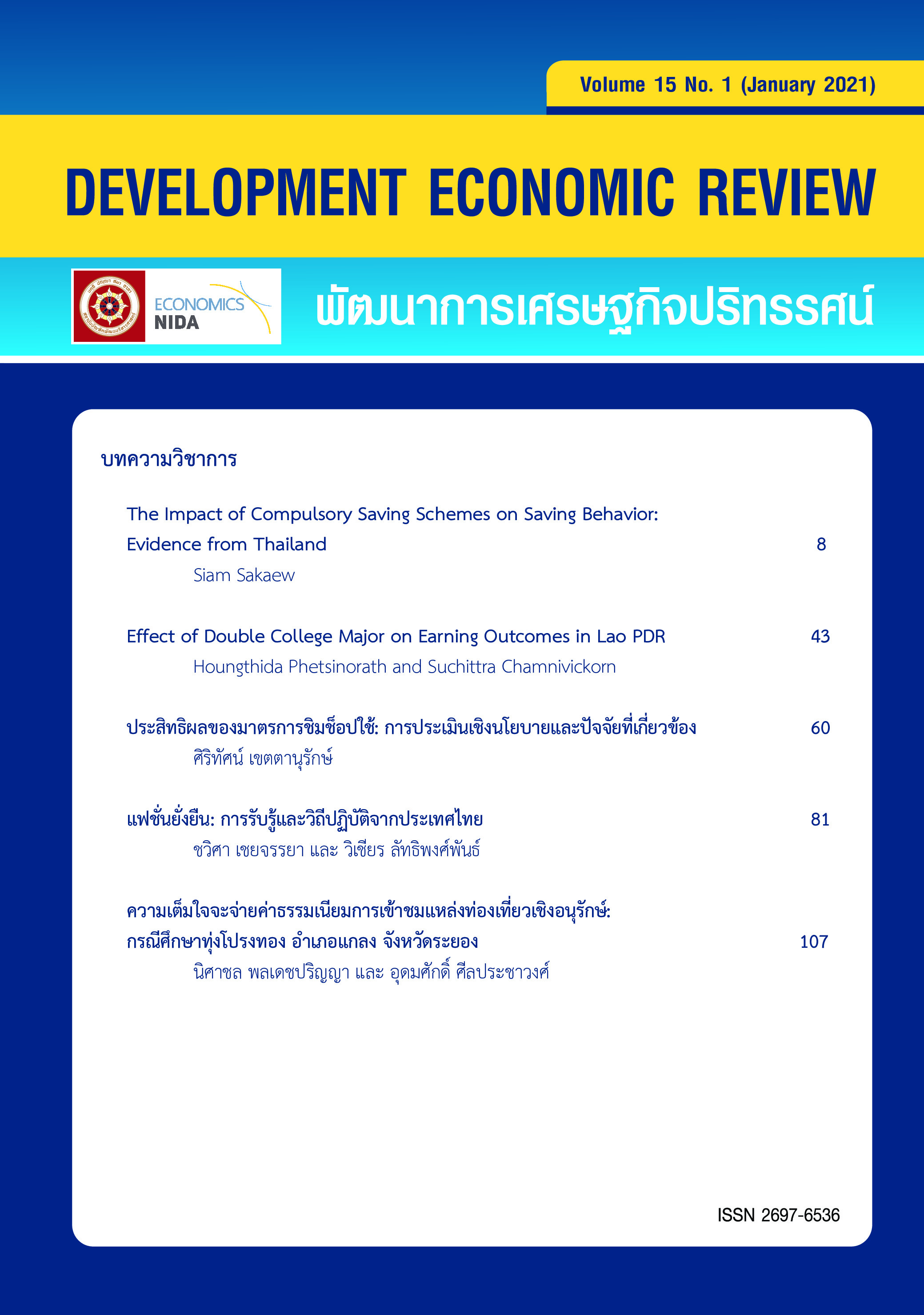Willingness to Pay for Entrance Fees of Ecotourism Attractions: A Case Study of Tung Prong Thong, Klaeng District, Rayong Province.
Keywords:
Willingness to pay, Contingent Valuation Method (CVM), Entrance Fee, Tung Prong ThongAbstract
The objectives of this study are: 1) to evaluate the tourists’ willingness to pay (WTP) for entrance fees of Tung Prong Thong by the Contingent Valuation Method (CVM). 2) to determine the appropriate an entrance fee. 3) to study various factors that affect tourists’ willingness to pay. The primary data was collected by the questionnaires with a sample of 400 Thai tourists aged 15 years and over. This study used the CVM, including close-ended single bound questions and open-ended questions. The results of the study for the estimate WTP by using close-ended single bound questions and analyzed by logit model show that there was independent variable that is statistically significant. This is the entrance fee rate variable (BID). The mean WTP is 40.88 baht per person per visit. The estimate WTP by using open-ended questions and calculated by using the arithmetic mean that the mean WTP is 33.77 baht per person per visit. The results for estimating the number of tourists and annual income from the entrance fee of Tung Prong Thong. Both of close-ended single bound questions and open-ended questions show that the entrance fee for maximum revenue is 20 baht per person per visit. Close-ended single bound questions estimated maximum revenue of 6,018,460 baht per year. While open-ended questions estimated maximum revenue of 6,086,280 baht per year.
References
Department of Marine and Coastal Resources, Ministry of Natural Resources and Environment. (2018). The Urban Forest Project: Miracle of the Mangrove Forest, Tung Prong Thong, Pak Nam Prasae. Retrieved from https://www.dmcr.go. th/miniprojects/58/22437 on 7 June 2019. (In Thai)
ณัฐดนัย สันธินันทน์ (255). การศึกษามูลค่การใช้ประโยชน์และความเต็มใจจ่ายค่าธรรมเนียม กรณีศึกษาป่าประ กิ่งอำเภอนบพิตำ จังหวัดนครศรีธรรมราช. (วิทยานิพนธ์ปริญญามหาบัณฑิต). มหาวิทยาลัยเกษตรศาสตร์.
Natdanai Santhinan. (2009). A Study of Use Value and Willingness to Pay for Entrance Fee: A Case Study of Eltaeriospermum tapos Forest, Nopphitam District Changwat Nakhon Si Thammarat. (Master's thesis). Kasetsart University. (In Thai)
ฤกษ์รัตน์ ปักกันต์ธร. (2548). การศึกษาความเต็มใจจ่ายคำธรรมเนียมของนักท่องเที่ยวที่ไปเยือนแหล่งนันทนาการทางธรรมชาติ: กรณีศึกษา วนอุทยานน้ำตกเจ็ดสาวน้อย จังหวัดสระบุรี.(วิทยานิพนธ์ปริญญามหาบัณฑิต). มหาวิทยาลัยเกษตรศาสตร์.
Rerkrat Pakkantorn. (2005). A Study of Wilingness to Pay for Entrance Fee by Visitors to Outdoor Recreation Areas: A Case Study of Chet Sao Noi Forest Park in Saraburi Province. (Master's thesis). Kasetsart University. (In Thai)
ศาศะวัต สุขสุอรรถ. (2552) การประเมินมูลค่าทางด้านนันทนาการและค่าธรรมเนียมการเข้าใช้ กรณีศึกษา สวนลุมพินี กรุงเทพมหานคร (ปริญญานิพนธ์ระดับปริญญามหาบัณฑิต) มหาวิทยาลัยตรีนครินทรวิโรฒ.
Sasawat Suksu-aut. (2009). Economic Valuation of Recreational Value and Entrance Fee: A Case Study of Lumpinee Park, Bangkok Metropolitan. (Master's thesis). Srinakharinwirot University. (In Thai)
อุดมศักดิ์ ศีลประชาวงศ์.(2561) การประเมินมูลค่าทางเศรษฐศสาตร์ของทรัพยากรสิ่งแวดล้อม (พิมพ์ครั้งที่ 2) กรุงเทพมหานคร: พี..เอ.ลีฟวิ่ง.
Udomsak Seenprachawong. (20 18). Economic Valuation of Environmental Resources (2nd ed.).Bangkok: P.A. Living. (In Thai).
Ahmad, S.A. (2009). Visitors’ Willingness to Pay for an Entrance Fee: A Case Study of Marine Parks in Malaysia. (Doctoral dissertation), Glasgow: University of Glasgow.
Hanemann, W.M. (1984). Welfare Evaluations in Contingent Valuation Experiments with Discrete Responses. American Journal of Agricultural Economics, 66(3), 332-341.
Khan, H. (2004). Demand for Eco-tourism: Estimating Recreational Benefits form the Margalla Hills National Parks in Northern Pakistan. South Asian Network for Development and Environmental Economics. 5: 1-35.
Machado, K.B. (2000). Willingness to Pay for Conservation Programs: A Contingent Valuation Study of the Galapagos National Park. (Doctoral dissertation). Ithaca: Cornell University.
Reynisdottir, M., Song, H., & Agrusa, J. (2008). Willingness to Pay Entrance Fees to Natural Attractions: An Icelandic Case Study. Tourism Management. 2(6), 1076-1083.
Yamane, Taro. (1973). Statistics: An introductory analysis (3rd ed.), New York: Harper and Row.

Published
Issue
Section
License
Copyright to published manuscripts becomes the property of the Graduate School of Development Economics, National Institute of Development Administration. Reproduction of all or part of a Development Economic Review (DER) article by anyone, excluding author(s), is prohibited, unless receiving our permission.
Disclaimer: Opinions expressed in articles published in this journal are those of the author (s) and do nto necessarily represent opinions of the Graduate School of Development Economics, National Institute of Development Administration. Trade and proprietary names are only for identification and not constitute our endorsement.

